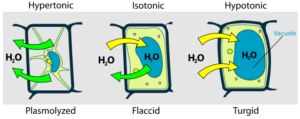What is the difference between turgidity and flaccidity?
Cells experience the movement of water into and out of the cell. The process of water movement is known as osmosis. Turgidity and flaccidity are two conditions that occur due to tonicity.
The core difference between turgidity and flaccidity is that turgidity is caused by endosmosis which involves the movement of water molecules into the cell while flaccidity is caused by exosmosis which causes water molecules to move out of the cell.

What Is Turgidity?
Turgidity is the swelling of the cell due to the high content of the fluid. The condition occurs when the cell is placed in a hypotonic solution.
The water pressure generates turgor pressure which pushes the protoplasm to the cell wall. The phenomenon is quite crucial in plant cells since it facilitates the opening and closing of stomata.
The phenomenon plays a huge role in the dispersion of seeds and spores since the cell of sporangia and fruits become turgid. The process prevents the plant from wilting and offer mechanical support.
What Is Flaccidity?
Flaccidity is the process where the cell maintains the normal shape. It occurs when the cell is placed in an isotonic solution. It implies that the cell experience both endosmosis and exosmosis.
The water potential of the surrounding and that of the cell sap have attained equilibrium due to an equal balance of endosmosis and exosmosis.
Comparison Chart: Turgidity vs Flaccidity
| Basic Terms | Turgidity | Flaccidity |
| Meaning | It is the state where the cell becomes swollen due to high fluid content | It is the state where the fluid in the cytoplasm balances with the surrounding fluid. |
| Type of Solution | Hypertonic | Isotonic |
| Type of Osmosis | Endosmosis | Both endosmosis and exosmosis |
| Water Movement | Move into the cell | Move out of the cell |
| Net Movement of Water | No more water entry into the cell | No more water movement out of the cell |
| Water Potential | Highest | Lowest |
| Plasma Membrane | Pushed to the cell wall tightly | Not pushed against the cell wall tightly. |
Core Difference Between Turgidity and Flaccidity
- Turgidity is when the cell swells due to the high content of fluid while flaccidity is where the fluid of the cell cytoplasm balances the surrounding fluid.
- The type of solution that causes turgidity is the hypotonic solution while that of flaccidity is an isotonic solution
- Turgidity is caused by endosmosis while flaccidity by both endosmosis and exosmosis
- Turgidity result in the movement of water molecules into the cell while flaccidity is the movement of water out of the cell
- Turgidity ensure no more water entry into the cell while flaccidity ensure no water movement out of the cell
- Water potential is high during turgidity while low during flaccidity
- The plasma membrane is pushed to the cell wall tightly during turgidity while flaccidity is not pushed against the cell wall tightly.
Read More: Difference between Wall Pressure and Turgor Pressure
Comparison Video
Summary
Turgidity is caused by endosmosis when cells are placed in a hypotonic solution while flaccidity is caused by both endosmosis and exosmosis when cells are placed in an isotonic solution.